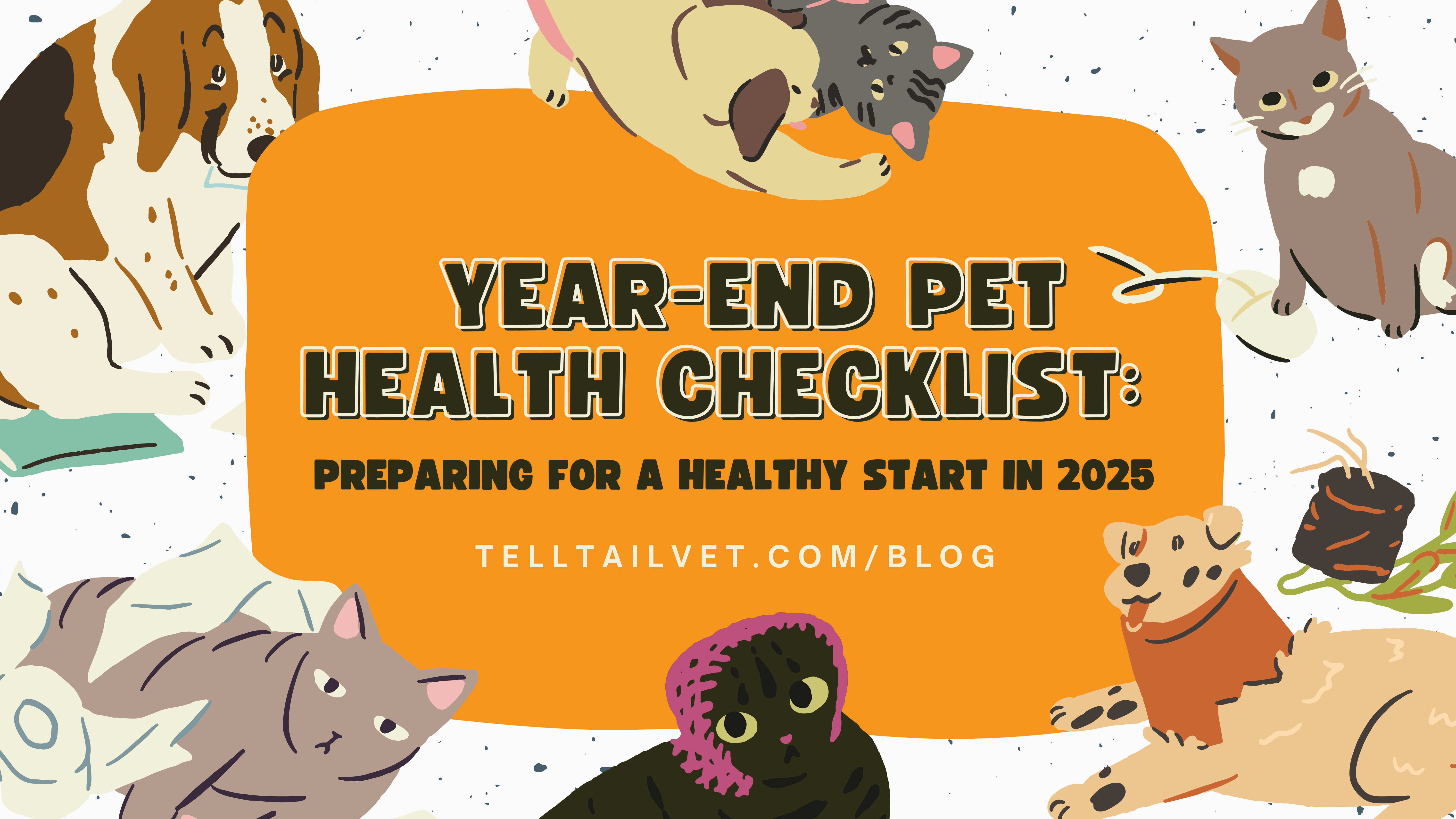
As we approach the end of the year, it’s the perfect time to ensure that your pet is set for a healthy and happy start to 2025. A little preparation now can go a long way in keeping your furry friend in top shape throughout the new year. At Tell Tail Veterinary Urgent Care, we’ve put together a comprehensive year-end pet health checklist to help you cover all the essential tasks before the calendar turns. Follow these steps to ensure your pet’s well-being and give them the best start to the new year.
1. Schedule a Wellness Exam
Why It’s Important: Regular wellness exams are crucial for detecting any health issues early and ensuring your pet is in good overall health. An annual check-up can help catch problems before they become serious and allows you to stay on top of vaccinations and preventive care.
What to Expect: During the exam, your veterinarian will conduct a thorough physical examination, check for any signs of illness, and discuss any concerns you may have. They may also recommend additional tests or treatments based on your pet’s age, breed, and health history.
Action Step: Call your primary veterinarian to schedule your pet’s annual wellness exam before the year ends. If you’re unsure of when your pet’s last check-up was, review your records or contact your vet for confirmation.
2. Update Vaccinations
Why It’s Important: Keeping vaccinations up-to-date is vital for protecting your pet from preventable diseases. Vaccinations also play a key role in community health by preventing the spread of contagious illnesses.
What to Check: Review your pet’s vaccination history to determine if any vaccines are due for renewal. Common vaccinations include those for rabies, distemper, parvovirus, and feline leukemia.
Action Step: Consult with your veterinarian to ensure your pet’s vaccinations are current. If any are due, schedule an appointment to get them updated before the year ends.
3. Review and Renew Preventive Medications
Why It’s Important: Preventive medications, such as flea, tick, and heartworm preventatives, are essential for keeping your pet protected from parasites and related diseases. Regular use helps avoid potential health issues and ensures your pet stays comfortable.
What to Check: Assess whether your pet’s current preventive medications are running low and if any renewals are needed. It’s also a good time to review your pet’s parasite prevention plan with your veterinarian.
Action Step: Refill any necessary medications and discuss with your vet if any changes to the preventive care plan are needed for the upcoming year.
4. Assess and Update Grooming Needs
Why It’s Important: Regular grooming is not only about maintaining your pet’s appearance but also about their overall health. Grooming helps prevent matting, reduces shedding, and allows you to check for skin issues or abnormalities.
What to Check: Evaluate your pet’s grooming needs, including nail trims, coat brushing, and dental care. Winter can also be a good time to assess if your pet needs a winter coat or additional skin care.
Action Step: Schedule any grooming appointments or set aside time to perform grooming tasks at home. Ensure you’re using pet-safe products and tools to keep your pet clean and comfortable.
5. Stock Up on Essential Supplies
Why It’s Important: Keeping your pet’s essentials well-stocked ensures you’re prepared for any situation and helps maintain their routine. This includes food, medications, grooming supplies, and any special items your pet may need.
What to Check: Review your pet’s current supplies to ensure you have enough food, medications, and other essentials. Check expiration dates on medications and make a list of items that need replenishing.
Action Step: Purchase any necessary supplies and consider setting up a regular delivery service for items like food and medications to keep your pet’s needs consistently met.
6. Review and Update Pet Insurance
Why It’s Important: Pet insurance can be a valuable resource for managing unexpected medical expenses. Reviewing your policy ensures that your coverage is up-to-date and that you’re aware of any changes to the terms or benefits.
What to Check: Assess your current pet insurance policy and verify that it covers your pet’s needs for the upcoming year. Make any necessary updates or changes to your policy to ensure comprehensive coverage.
Action Step: Contact your insurance provider to review your policy and make any necessary updates or adjustments.
7. Set Goals for Your Pet’s Health and Wellness
Why It’s Important: Setting health goals helps keep your pet on track for a healthy year ahead. Consider areas such as weight management, exercise routines, and dietary adjustments.
What to Check: Evaluate your pet’s current health and wellness routine and identify any areas for improvement. Setting goals for regular exercise, balanced nutrition, and weight management can make a big difference.
Action Step: Discuss your goals with your veterinarian and develop a plan to achieve them. Regular follow-ups and adjustments will help keep your pet’s health on track.
Conclusion
Completing this year-end pet health checklist will help ensure that your furry friend starts 2025 in great shape. From scheduling wellness exams to updating vaccinations and reviewing preventive care, taking these steps now will set the foundation for a healthy and happy year ahead. At Tell Tail Veterinary Urgent Care, we’re here to support you and your pet. Here’s to a healthy and joyful New Year for you and your beloved pets!

